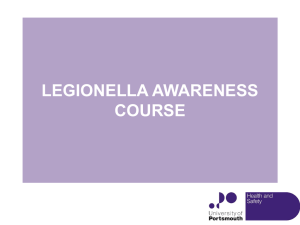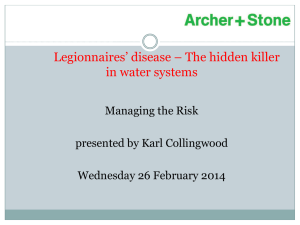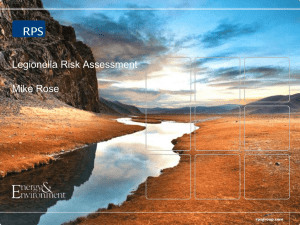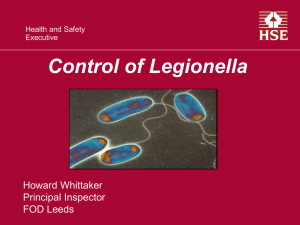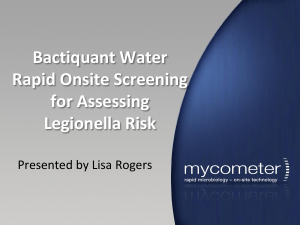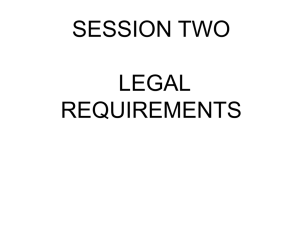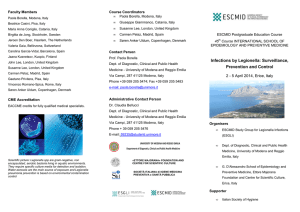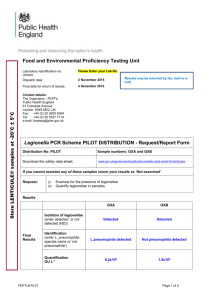Trust policy and guidelines for control and prevention
advertisement
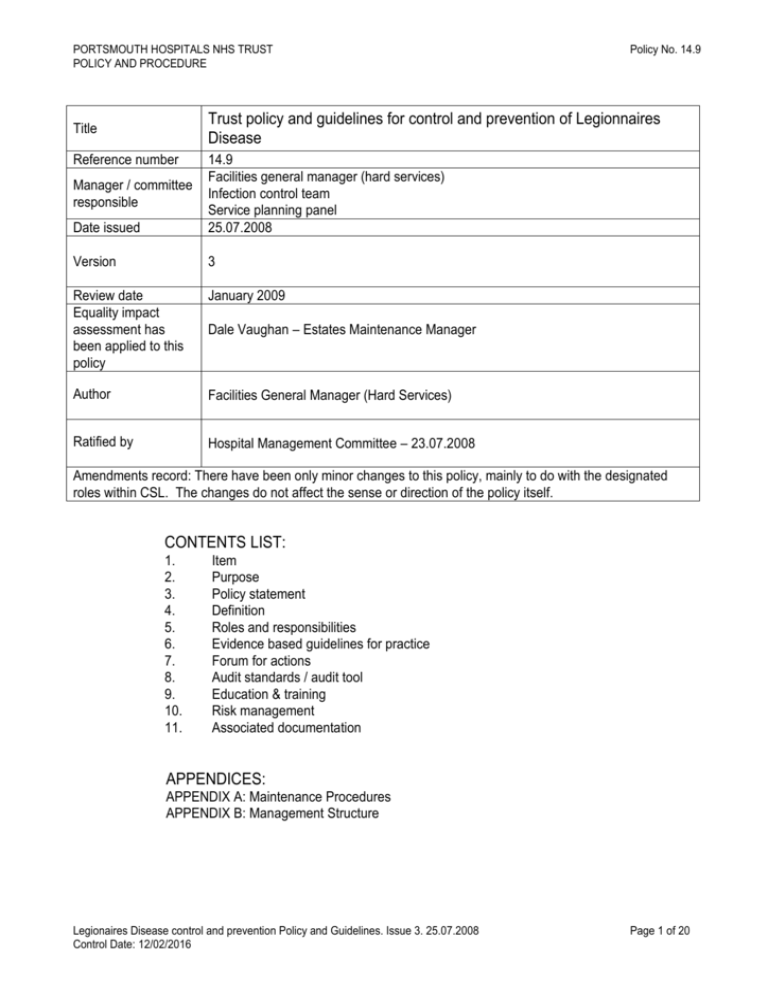
PORTSMOUTH HOSPITALS NHS TRUST POLICY AND PROCEDURE Policy No. 14.9 Trust policy and guidelines for control and prevention of Legionnaires Disease Title Reference number Date issued 14.9 Facilities general manager (hard services) Infection control team Service planning panel 25.07.2008 Version 3 Review date Equality impact assessment has been applied to this policy January 2009 Author Facilities General Manager (Hard Services) Ratified by Hospital Management Committee – 23.07.2008 Manager / committee responsible Dale Vaughan – Estates Maintenance Manager Amendments record: There have been only minor changes to this policy, mainly to do with the designated roles within CSL. The changes do not affect the sense or direction of the policy itself. CONTENTS LIST: 1. 2. 3. 4. 5. 6. 7. 8. 9. 10. 11. Item Purpose Policy statement Definition Roles and responsibilities Evidence based guidelines for practice Forum for actions Audit standards / audit tool Education & training Risk management Associated documentation APPENDICES: APPENDIX A: Maintenance Procedures APPENDIX B: Management Structure Legionaires Disease control and prevention Policy and Guidelines. Issue 3. 25.07.2008 Control Date: 12/02/2016 Page 1 of 20 PORTSMOUTH HOSPITALS NHS TRUST POLICY AND PROCEDURE 1. 2. Policy No. 14.9 ITEM. Trust Policy and Guidelines for Control and Prevention of Legionnaires Disease PURPOSE 2.1 Introduction The responsibility of the building owner to ensure that the facilities they provide in their properties achieve the desired standards, within accepted criteria, Portsmouth Hospitals NHS Trust (PHT) as the owner of all the buildings on its sites recognises they require regular monitoring. Water quality is an area, which has been the subject of much publicity and discussion, fuelled by recurring outbreaks of Legionnaires Disease and an increasing awareness of the measures available to control and maintain acceptable standards. PHT accept their responsibilities to take every reasonable precaution necessary to protect the people occupying and visiting their hospital, as well as passers by, within the vicinity of their hospital. Legionnaires Disease can prove fatal as confirmed by a number of cases, all of which could have been prevented. It is these preventative measures that PHT wish to address across their portfolio for the protection of patients, staff, contractors and visitors. The associated liability of such an outbreak, coupled with public attention attaching to even a suspected outbreak necessitates the need for clear, concise guidelines to be published, recommending measures to be taken to prevent the Legionellae bacterium becoming active within the buildings owned, managed and maintained by PHT. Water services, in particular hot water services, humidifiers, cooling towers, together with air supply systems are the sensitive areas requiring close scrutiny regarding maintenance methods, monitoring, testing and procedures. This has been emphasised by many studies of such services, and in available documentation relating to maintenance and monitoring of water systems. In new, unoccupied or partially occupied buildings, special care must be taken, as the circumstances therein require bespoke solutions dependant upon the individual circumstances encountered. 2.2 User Guide This policy document necessarily contains much detail as it covers the mixture of Building Services Maintenance and Design, Legislation, Microbiological and Contaminant Control, together with procedures, which are required to manage water supplies within the PHT properties to limit the risk associated with Legionnaires Disease. The PHT policy statement is included at the beginning of the document (Section 3). What follows is further information on how to achieve or maintain this policy. When using the document ensure that the whole text relating to each sub section is read so that all information necessary is received. 3. POLICY STATEMENT Portsmouth Hospitals NHS Trust recognises and accepts responsibility as an employer for providing, as far as is reasonably practicable, a safe environment for its employees and any person legally on its premises. In addition, all such persons have a duty of care to ensure their own health and safety whilst on the premises. Legionaires Disease control and prevention Policy and Guidelines. Issue 3. 25.07.2008 Control Date: 12/02/2016 Page 2 of 20 PORTSMOUTH HOSPITALS NHS TRUST POLICY AND PROCEDURE Policy No. 14.9 The Trust also requires employees to take reasonable care of their own health and safety, and that of other persons who may be affected by their acts or omissions at work. Employees are also required to cooperate with the Trust and any person to enable them to meet their own statutory obligations. 3.1 The Control of Legionellosis – A Summary Legionella was first shown to be a causative organism of an outbreak of pneumonia in 1976 following a conference in a Philadelphia hotel used by American ex-servicemen (Legionnaires) – Legionella pneumophila. Subsequently many other related organisms have been identified from environmental sources and patients, some of the organisms isolated from the environment have yet to be shown to cause human disease. The natural habitat of the legionellas is the water of streams, rivers, lakes and the mud of river banks where they cause no problems to man; however if transferred in significant numbers into water supplier or air conditioning units, especially in large buildings such as hospitals they can cause outbreaks of disease. Legionellas in Water Supplies As already stated these are common in many water supplies and in small numbers probably do no harm. If however they are allowed to multiply in stagnating tanks or little used showers etc, and then transported to susceptible patients in contaminated aerosols or sprays most likely sources are taps, shower heads and air conditioning systems particularly those with cooling towers. Prevention Legionella in water supplies or air conditioning systems may be almost impossible to eradicate therefore it is essential to adopt a series of control measures in order to reduce the risk factors. This document makes reference to the methods the Trust will adopt to manage this risk. 4. DEFINITION 4.1 Introduction Water has many uses, i.e. drinking, bathing and cooling. It can also be used as a heat source for heating and hot water purposes. However water can be harmful when its temperature is too extreme to be tolerated by the body. It can also be a vehicle for infectious micro-organisms. The Trust management have a duty to make full use of the potential benefits of using the water service. They have a statutory responsibility to take appropriate measures for the control of all water-borne micro-organisms such as Legionella. The effectiveness of all precautionary measures should be regularly monitored and a continuing programme of awareness should be implemented. Complacency leading to the deterioration of water hygiene to the extent that an outbreak of Legionnaires Disease occurs is the highest risk. The Trust’s intention is to remove the threat wherever possible of all potential sources of growth and spread of Legionella. Where this ideal may not be achievable in existing situations, such steps will be taken to control Legionella by proper management of the system. Legionellae pneumophila is the bacterium, which causes Legionnaires disease. This is identified as a pneumonia – type infection of the lower respiratory tract. The infection is most commonly acquired by the inhalation of the air-borne droplets or particles containing viable Legionella. Legionaires Disease control and prevention Policy and Guidelines. Issue 3. 25.07.2008 Control Date: 12/02/2016 Page 3 of 20 PORTSMOUTH HOSPITALS NHS TRUST POLICY AND PROCEDURE Policy No. 14.9 Investigations have shown that levels of Legionellae contamination are greater in Hot and Cold Water Services than in Cooling Towers. However it should be remembered that the contamination “footprint” of a Wet Cooling Tower is larger than that of any other likely source. This is due to the wind spread of the vapour emitted from the cooling tower Legionellae ecology in water systems is not entirely understood. However, the following conditions have been documented as affecting its rate of growth. The presence of sediment, sludge, scale, organic material and other micro-organisms provide the ideal growth medium for Legionella. If biofilms are formed these will protect the Legionella from the action of biocides. Installations containing biofilms can harbour and provide favourable conditions for Legionellae growth. Legionellae, which can grow in Protozoa and within biofilms, may be protected from biocides that would otherwise kill of inhibit growth within the water system. Legionellae will proliferate in water systems, held at temperatures of between 20 oC and 45oC. The Human blood temperature of approximately 37oC is that at which the bacterium is most active. The ideal conditions for Legionellae is stagnant water held between 20 oC and 45oC. Legionellae will survive at temperatures below 20oC but is considered to be in a dormant state with no colonisation activity. The bacterium does not survive temperatures maintained constantly at 60oC or above. 5. ROLES AND RESPONSIBILITIES Infection Control Team The Chief Executive of PHT shall nominate in writing an infection control team (Legionellae) for advising on and monitoring infection control policy for Legionnaires disease. The infection control team (Legionellae) should be involved in the production of the policy and management procedures for the control of Legionellae. Similarly, the team has a key role in formulating the plans and ensuring its implementation. Nominated Person A Nominated Person (Legionellae) possessing professional knowledge and with appropriate training shall be nominated in writing by PHT Chief Executive to devise and manage the necessary procedures for the prevention of Legionnaires disease. The Nominated Person shall liase closely with other professionals in various disciplines. The person nominated shall possess a thorough knowledge of the control of Legionellae. The person should have sufficient authority to ensure that measures are carried out effectively. The nominated person shall have a designated deputy also appointed in writing by PHT. Legionaires Disease control and prevention Policy and Guidelines. Issue 3. 25.07.2008 Control Date: 12/02/2016 Page 4 of 20 PORTSMOUTH HOSPITALS NHS TRUST POLICY AND PROCEDURE Policy No. 14.9 High Risk Conditions These will be systems where: 1) Water temperatures are between 20oC and 50oC, therefore, water supplies should be held out of this range wherever practicable. 2) There is sediment, sludge, scale, organic materials and iron oxide in storage tanks and service pipework. Therefore regular cleaning of such services is essential to reduce the risk. 3) Algae, amoebae and other bacteria, survive a regular disinfection and cleaning programme, which must be monitored to prevent the build up of biofilms etc. 4) The use of some rubbers, leathers, jointing compound, mastics, wooden packing and certain plastics should be avoided as they can provide a nutrient source for Legionella. Guidance is available from the Water Research Centre; see the Approved Code of Practice and Guidance (L8). 5) The formation of biofilms within a water system also provides a nutrient source and a safe harbour for Legionella. A biofilm is primarily a layer of micro-organisms combining a matrix, which forms a surface slime when in contact with water. 6) Exposure of water to sunlight may stimulate the growth of algae and the formation of slimes. Also stagnant water encourages colonisation of Legionella. 7) The water is allowed to become stagnant. High Risk Areas These are areas that have: 1) Air conditioning systems, humidifiers and chiller battery installations 2) Hot water services and storage cylinders 3) Cold water services and storage tanks 4) Water systems which produce aerosols that may exceed a temperature of 20 oC 5) Spa baths, whirlpools, hydro therapy and swimming pools 6) Water systems incorporating a cooling tower High Risk Patients These are patients being treated for: a) Respiratory illness b) HIV/AIDs c) Head/ neck cancer d) Renal dialysis and organ transplant e) Leukaemia/ oncology/ bone marrow transplant f) Immuno suppressed patients Legionaires Disease control and prevention Policy and Guidelines. Issue 3. 25.07.2008 Control Date: 12/02/2016 Page 5 of 20 PORTSMOUTH HOSPITALS NHS TRUST POLICY AND PROCEDURE Policy No. 14.9 Methods of Prevention Mechanical Services a) Removing all taps and outlets and associated pipework which are not used or are under-used. Systems b) Ensure that the hot water temperatures for calorifiers and hot water storage vessels are maintained at a temperature at or above 60oC and that this temperature does not fall below 50 oC at any point within the circulation pipework. c) Ensure that all pipework carrying blended water at temperatures of between 25oC and 43oC minimum is restricted to as short a distance from the outlet as is practically possible. d) Reduce the length of any deadlegs or spurs away from the main hot water circulatory system to a minimum. e) Avoid stagnation. f) Maintain stringent cleanliness of water systems and ventilation systems. g) Use of the proper water treatment regime in wet cooling towers. h) Introduce the correct level of maintenance to ensure correct and safe operation and compliance with statutory regulations. i) Reduce the amount of water stored in tanks to a minimum (24 hours maximum). j) Keep all water storage systems clean and sealed from extraneous matter and contamination; also maintain temperatures below 20oC for cold-water services. k) Introduction of a system of continuous dosing of the incoming cold water services using a recognised chemical solution or other approved means would assist in reducing the risk from Legionella and other water borne micro-organisms. This may also allow domestic hot water temperatures to be reduced, thereby, considerably reducing the risk of scalding by patients, staff and visitors. Legionaires Disease control and prevention Policy and Guidelines. Issue 3. 25.07.2008 Control Date: 12/02/2016 Page 6 of 20 PORTSMOUTH HOSPITALS NHS TRUST POLICY AND PROCEDURE Policy No. 14.9 Organisational Responsibilities Management Arrangements for Legionella (Specific names are contained in Appendix B) Chief Executive Director Development and Estates Infection Control Doctor/Team Client Team Health and Safety Advisor Nominated Person Legionella Deputy Nominated Person Legionella Responsible Person Chief Executive To take overall responsibility to ensure that the policy for the control of Legionella is implemented and that appropriate funding is made available to carry out any capital and revenue implications of it. In practice the Chief Executive delegates the day to day implementation to the Director of Facilities Management, but retains the following duties: o To appoint the Nominated Person (Legionella) and infection Control Doctor (Legionella) o To appoint the Infection Control Doctor (Legionella) Director of Development and Estates To take responsibility of passing concerns from Infection Control, Health & Safety and Nominated Person back to the Trust. Legionaires Disease control and prevention Policy and Guidelines. Issue 3. 25.07.2008 Control Date: 12/02/2016 Page 7 of 20 PORTSMOUTH HOSPITALS NHS TRUST POLICY AND PROCEDURE Policy No. 14.9 Client Team To act as liaison for all concerns or related issues to be passed back to the Director of Development and Estates. Nominated Person (Legionella) To produce, develop and implement the Legionella policy. Produced in association with advice from competent persons. To appoint a Deputy Nominated Person (Legionella) Ensure all water systems have schematic drawings available that are current. Ensure that Risk Assessments are carried out annually or after any changes or alterations to the water systems, with advice from competent persons where deemed necessary. Identify to the Hospital Management Team the necessary funding to implement the procedure and any improvement or alterations required to comply. Carry out an annual audit of the procedures to ensure compliance. Deputy Nominated Person (Legionella) To undertake the following duties: Monitor the efficacy of the procedures. Ensure adequate and consistent records are maintained throughout the Trust. Deputise for the nominated person (Legionella) when they are not available. Infection Control Doctor (Legionella) To advise the Nominated Person (Legionella) on suitable policies for the minimisation of risk from Legionella. Assist with the implementation of the policy. Health & Safety Advisor To provide health and safety advice to the Nominated and Responsible Persons and to feed back to the Health and Safety Advisory Group. Responsible Person(s) (Legionella) Advise on the potential areas of risk and identify to the Nominated Person where systems do not comply with current standards/guidance. Advise on the required controls and procedures for the prevention of Legionella. To operate and maintain the plant and systems in accordance with the policy and procedures for the control of Legionella. Ensure adequate records are maintained. To ensure that all staff (directly employed or contractors) are trained in the correct procedures and are aware of the standards required and expected of them in discharging their duties in compliance with the policy for the control of Legionella. Maintain records of inspections, cleaning, disinfection and pasteurisation regimes, maintenance, alterations, repairs and operational abnormalities. Legionaires Disease control and prevention Policy and Guidelines. Issue 3. 25.07.2008 Control Date: 12/02/2016 Page 8 of 20 PORTSMOUTH HOSPITALS NHS TRUST POLICY AND PROCEDURE Policy No. 14.9 Directly Employed Artisan Staff (including Bank & Agency Maintenance Staff) All staff must adhere to the Control of Legionella policy and procedures, working structures and current codes of practice at all times. Comply with the policy and standards laid down in the policy for the minimisation of Legionella. Contractors All contractors employed by PHT are responsible to them to carry out their activities in a way, which complies with the Legionella policy, procedures and working structures. The above includes verbal instructions as considered appropriate by the Estates Officer to whom they are accountable. Building Surveyors and Staff Development Team staff and any appointed building consultants are responsible for ensuring the Nominated Person is informed at all stages of the design where the integrity of the water supply is at risk. The Nominated Person shall have an input into any development schemes to ensure that the risk is minimal. To comply with the Construction Design and Management (CDM) Regulations, information about the existing system that is to be modified will be passed to the Consultant, together with the operation criteria that has been achieved for the system. No system will be accepted unless the Nominated Person (Legionella) is agreeable. Category Portsmouth Hospitals NHS Trust Nominated Person (Managerial) 6. Organisational Arrangements Definition The person or persons appointed to take managerial responsibility and to supervise implementation of the policy for Legionella control EVIDENCE BASED GUIDELINES FOR PRACTICE 6.1 Statutory Safety Codes of Practice Portsmouth Hospitals NHS Trust in implementing this policy will use as a general source of practical guidance “The Health and Safety Commission’s Approved Code of Practice and Guidance (L8); The Prevention or Control of Legionellosis (including Legionnaires Disease) made with the consent of the Secretary of State under Section 16 of the Health and Safety at Work Act 1974. With regard to the detailed practical guidance of implementing this policy, PHT will use the detailed technical advice on design, maintenance, operation and management of water systems given in the Health and Safety Commission Publication “The Approved Code of Practice and Guidance (L8) and the NHS Estates documents entitled “Health Technical Memorandum 2040 The control of Legionella in Health Care Premises – A Code of Practice in Five Volumes and Health Guidance Note entitled “safe” hot water and surface temperatures”. 6.2 Trust Responsibilities The Trust recognises its responsibility to implement in full the codes of practice as defined in the Health and Safety Commissions document and for specific guidance the NHS Estates Approved Code of Practice HTM 2040 and Safe water guidance notes in order that they can properly control their water system. Legionaires Disease control and prevention Policy and Guidelines. Issue 3. 25.07.2008 Control Date: 12/02/2016 Page 9 of 20 PORTSMOUTH HOSPITALS NHS TRUST POLICY AND PROCEDURE i) ii) iii) iv) v) Policy No. 14.9 Identify and assess sources of risk Prepare a scheme for preventing or controlling the risk Implement and manage precautions Implement a safe system of working Keep records of the precautions implemented and will do so for each of the health care premises within the Trust’s control 6.3 Statutory and Delegated Legislation applying to the Control of Water Services a. Health and Safety at Work Act 1974 The management have a duty to ensure that there is an appropriate regime for the proper design, installation and maintenance of plant and systems. A proper system of work and adequate control measures are essential to conform with this act. b. Management of Health and Safety at Work Regulations 1999 To comply with these regulations the management must make a systematic assessment of risks to health for their employees and others arising from work activities. c. Control of Substances Hazardous to Health (COSHH) Regulations 2002 The regulations require management to ensure that suitable measures are in place to protect staff and others from exposure to substances, which may be hazardous to health including microorganisms whilst carrying out their normal duties. d. Public Health Infectious Diseases Regulations 1988 In the event of a serious outbreak of any disease then the Infection Control Doctor on behalf of the Trust shall inform the Consultant for Communicable Disease Control at the Local Authority. Since April 2003 this is known as the Health Protection Agency. e. Water supply Regulations 1999 Management shall ensure with the advice of Infection Control that water is stored correctly and that correct measures are taken to ensure avoidance of system contamination. f. The Food Act 1999 The managers must ensure observance of this act when water is used in the preparation of food and for drinking purposes. g. The Approved Code of Practice and Guidance (L8) The Management have a duty to observe the procedures. h. Notification of Cooling Towers and Evaporative Condensers Regulations 1992 Trusts are required to register such units with the Local Authority and are subject to their inspections and requirements. In addition the following procedure documents and guidance notes should be referred to for guidance: i) Water Suppliers – Water Supply Regulations (Water Quality) July 1999 ii) Technical Memorandum TM13 – Minimising the Risk of Legionnaires Disease, CIBSE. iii) BS6700 iv) HTM 2040 – The Control of Legionella in Healthcare Premises v) HTM 2027 – Cold Water Supply Storage and Mains Distribution Legionaires Disease control and prevention Policy and Guidelines. Issue 3. 25.07.2008 Control Date: 12/02/2016 Page 10 of 20 PORTSMOUTH HOSPITALS NHS TRUST POLICY AND PROCEDURE vi) vii) viii) ix) x) xi) xii) xiii) xiv) 7. Policy No. 14.9 The statutory instrument 1992 No. 2225 Health and Safety Commission – The Notification of Cooling Towers and Evaporative Condenser Regulations 1992 The Water Fitting and Materials Directory The EEC Standards and Directives The British Standards Guidance Notes Other HSE Guidance Notes The Institute Of Plumbing Guide The BACS Codes of Practice The Water Management Society Guidance in Relation to Legionellosis NHS Estates Health Guidance Note “Safe” hot water and surface temperatures FORUM FOR ACTIONS. Persons who will be involved in discussions and alterations to the policy will be: Nominated Person Infection Control Doctor Health & Safety Advisory Group ACTION ONE The Infection Control Doctor will inform the Responsible Person (Legionella) for that site and the other members of the Infection Control Team. ACTION TWO The Responsible Person (Legionella) will immediately make the necessary preparatory arrangements to carry out disinfection and or pasteurisation of the relevant water system. ACTION THREE The Infection Control Doctor will convene a meeting to consider the urgency and extent of the action to be taken in the meeting will be: Infection Control Team members Nominated Person (Legionella) Responsible Person (Legionella) Ward or Departmental Manager Health and Safety Advisor ACTION FOUR Undertake remedial action as described in the section detailing Major Cleaning and Disinfection. The Responsible Person (Legionella) or an appointed Specialist should supervise remedial actions. If there is any doubt whatever about how to achieve the eradication, specialist assistance must be sought. ACTION FIVE Further samples will be taken as advised by the Infection Control Team. Legionaires Disease control and prevention Policy and Guidelines. Issue 3. 25.07.2008 Control Date: 12/02/2016 Page 11 of 20 PORTSMOUTH HOSPITALS NHS TRUST POLICY AND PROCEDURE Policy No. 14.9 Action to be taken in the event of a possible Outbreak of Legionnaires Disease ACTION ONE Liase with the Consultant Medical Microbiologist to confirm the diagnosis and place of acquisition and ensure correct patient samples are sent. ACTION TWO The Infection Control Doctor will review the location of the patient/ staff member and in conjunction with a responsible person Legionella will arrange a review of any relevant water systems and arrange sampling. ACTION THREE Measures must be taken by the Estates Department at this stage to reduce exposure of any other susceptible persons. ACTION FOUR A group should be set up to review the water sampling results and decide what further actions need to be taken. The group would normally include: Infection Control Doctor Member of Infection Control Team from Health Protection Agency Consultant for Communicable Disease Control Senior Manager from the Trust A Clinical Consultant, if patients are involved ACTION FIVE If more than two cases then an Outbreak Control Group should be convened. 8. AUDIT STANDARDS 8.1 All the following assume that the systems being examined have had a full risk assessment carried out on them and have been maintained since that in accordance with the recommendations as outlined in the appropriate ACOP (L8). In the hospital environment full implementation of HTM 2040 will result in compliance with the (L8) ACOP. The user of this document is also reminded that: a. there has never been an outbreak recorded to date that has been caused by a water system that has been strictly maintained in accordance with (L8). b. Failure to comply with the (L8)/ HTM 2040 will result in an increased risk. c. No control can guarantee the elimination of Legionellae from a water system. 8.2 Hot and Cold Water Systems These should only be examined for Legionella under the following circumstances: a) Where there has been an outbreak or problem previously. Legionaires Disease control and prevention Policy and Guidelines. Issue 3. 25.07.2008 Control Date: 12/02/2016 Page 12 of 20 PORTSMOUTH HOSPITALS NHS TRUST POLICY AND PROCEDURE Policy No. 14.9 b) To monitor the effectiveness of control measures taken in place of relying on the “temperature regime” (hot water circulated at least at 60oC and delivered at least at50oC within 1 minute of opening an outlet and below 20oC at the cold outlet). c) For outbreak investigations. d) In areas housing high-risk patients, e.g. renal transplant units. In other situations, risk management and monitoring should be based on carefully monitoring the temperatures and regular maintenance in accordance with HSC ACOP (L8). 8.3 For the levels at which action needs to be taken and what action needs to be taken after a positive test result is received please refer to tables 1 and 2 below. Table 1: Action in Response to Legionella Counts in Swimming or Hydro Pools Legionella / Litre Interpretation 2 <10 Retest immediately an carry out close review of control procedures Disinfect immediately, carry out close review of control procedures and 102 – 103 modify if appropriate, retest 2 to 7 days after disinfection Close pool, disinfect and clean, carry out close review of control procedures and modify if appropriate, retest 2 to 7 days after >103 disinfection. Leave pool disinfection, pumps etc operating as normal but do not open for use until the result of the Legionella test is known Table 2: Action in Response to Legionella Counts in Hot and Cold Water Systems Legionella/ Proportion of Action Litre site/s positive 2 < 10 0 – 50% Maintain normal controls Review controls, consider additional measures, examine <102 > 50% outlets in detail, retest, consider disinfection Review controls, consider additional measures, examine 102 - 103 0 – 50% outlets in detail, disinfect system and retest, alert clinicians Review controls, consider additional measures, examine 102 - 103 60 – 100% outlets in detail, disinfect system and retest, alert clinicians Review controls, consider additional measures, strip down all positive outlets replacing synthetic rubber components with > 103 10 – 20% new and cleaning and disinfecting the other components, disinfection of the system and retest, alert clinicians Evacuate high-risk patients and consider complete closure until problem eliminated. Review controls, consider additional > 103 > 30% measures, strip down all positive outlets replacing all synthetic rubber components and disinfecting the other components, disinfect the system and retest, alert clinicians 9. EDUCATION AND TRAINING The Nominated Person and Responsible Persons will require regular training and to have updated training in the various subjects that are involved with the control of Legionella. This will include: - Legionaires Disease control and prevention Policy and Guidelines. Issue 3. 25.07.2008 Control Date: 12/02/2016 Page 13 of 20 PORTSMOUTH HOSPITALS NHS TRUST POLICY AND PROCEDURE 1. 2. 3. Policy No. 14.9 Logbook awareness Management of Maintenance of Hydro & Swimming Pools Managing Legionella in Buildings It will be the responsibility of the Nominated Person to ensure that the Responsible Persons are kept up to date with changes in Legislation and carry out regular spot checks on the methods employed to control Legionella. 10. RISK MANAGEMENT It is essential to identify all possible risk areas. Priority for any remedial actions must be given to the highrisk areas. 10.1 Risk Assessment Procedures The Approved Code of Practice clearly states the requirement for employers and others to undertake assessments to establish the risk of Legionella. In pursuance of this policy the responsibility to carry this out rests with the Responsible Person (Legionella), supported by the Nominated Person (Legionella). A number of factors are required to increase the risk of acquiring Legionellosis, namely: 1. Condition of the water and the existence of suitable conditions for the organism to grow and multiply in the storage and distribution systems, i.e. suitable temperatures ideally between (20oC – 45oC) and a source of nutrients e.g. organic matter such as sludge, scale, rust or algae. 2. The presence of people to expose, particularly the vulnerable e.g. patients in healthcare premises. 3. A means of creating an aerosol or small breathable droplet such as from a shower. 4. The presence of the bacteria If at least one of these factors is missing, then Legionnaires Disease is less likely to occur. If all factors are present then the objective must be to remove one or more of them. In practice the risk can be dealt with by identifying potential sources of dissemination and preventing conditions, which may allow the proliferation of Legionella bacteria. If all factors are present then the Legionella risk is increased. A site survey of the water systems should be undertaken for each premises, it shall including a list of all associated plant and equipment, such as calorifiers, boilers and pumps etc. Either as fitted drawings or schematic drawings showing the configuration of services is also required, as is a description of the water system indicating the normal operating parameters; maintenance schedules and actions to be taken if and when abnormal situations occur. When a risk is identified the findings must be recorded and employees informed. Appropriate actions to reduce control the risk must be taken, vigorously monitored to ensure effectiveness. Assessments must be reviewed at least every two years, or more frequently if changes to the system are made or risks change. A detailed list of considerations is contained in Part 1 of the Approved Code of Practice. The Infection Control Doctor and Infection Control team will advise on the susceptibility of patients that may influence the control measures. Legionaires Disease control and prevention Policy and Guidelines. Issue 3. 25.07.2008 Control Date: 12/02/2016 Page 14 of 20 PORTSMOUTH HOSPITALS NHS TRUST POLICY AND PROCEDURE Policy No. 14.9 In carrying out the risk assessment so the following should be borne in mind: The HSE considers Legionella infection to be preventable Legionella is present in most water systems, we cannot eradicate it, but we can control the risk. The Responsible Person (Legionella) will initially review the record drawings and schematics of all the water systems. The drawings will show: a) The layout and arrangement of all calorifiers and pumps b) The layout and arrangement of all cisterns, humidifiers and cooling towers c) All other water systems, such as hydrotherapy pools, which may present a Legionellosis hazard d) Dead –legs and blind ends, with lengths and diameters indicated e) Operation and checkpoints for cross-referencing with operational instructions and temperature records. The Responsible Person (Legionella) will note any deficiencies in the record drawings and/or schematics: where obvious controls are not in place or where dead-legs are excessive. The Responsible Person (Legionella) will also review the documentation of the engineering design and the level of maintenance and operational procedures being performed. 1. The Responsible Person (Legionella) will then arrange for the physical Inspection of the various water systems from the entry sources to the Trust’s property to the various water outlets following: i. Trace all water pipework systems ii. Measure the time taken to achieve the recommended temperatures at hot and cold outlets iii. Checking layouts and arrangements of tanks, cisterns, calorifiers, pumps and humidifiers iv. Measure water temperatures at all systems, calorifiers, humidifiers, cooling towers and all other strategic points to ensure and check compliance v. Identify any redundant or little used outlets together with the associated pipework that could be removed vi. Upon completion of these surveys, the Infection Control team will consider the risk and develop a scheme for risk control in order of priority The assessment should be reviewed annually or sooner if it is thought that the original assessment may no longer be valid. Such circumstances would typically include: a) Changes to plant or water systems or its use b) Changes to the use of the building in which the water system is installed c) New/revised information relating to risk control measures d) The result of checks, which indicate that control measures are no longer effective. These may be elevated TVC (total viable count) levels or a positive sample analysis result when tested specifically for the presence of Legionella. The following sources are those most likely to promote conditions where Legionella will thrive and are capable of creating droplets, which become airborne and in turn can be inhaled. Legionaires Disease control and prevention Policy and Guidelines. Issue 3. 25.07.2008 Control Date: 12/02/2016 Page 15 of 20 PORTSMOUTH HOSPITALS NHS TRUST POLICY AND PROCEDURE Policy No. 14.9 10.2 Cooling Towers PHT does not have any cooling towers on their sites. 10.3 Air Conditioning Plant and Ductwork Within an air conditioning system, accumulations of water occur at various points throughout the distribution ductwork, depending on weather conditions and the demands of the control system. This is a potential habitat for Legionella. 10.4 Hot and Cold Water Systems The potential risk within hot and cold water systems can be increased by a number of indicators including; excess water storage capacities, inadequate sealing of water tanks by the lack of lids, ill fitting lids, unscreened overflow pipes; and inadequate or unsuitable thermal insulation. The lack of circulation flow in water tanks created by unsuitable or incorrect positioning of water inlet and discharge connections resulting in stagnation should also be considered. Temperature stratification, stagnation and sediment build up can occur in domestic hot water calorifiers and heaters. Hot water systems should supply water to all outlets; taps etc.; at a temperature of at least 40oC, this is for all public and patient accessible outlets. In some cases this may prove difficult to achieve because of inadequate insulation or poor circulation. In such cases, careful risk assessment of these circuits and outlets must be made to determine appropriate action. Pipework dead-legs have often contributed to the proliferation of Legionella in that they often contain sediment, sludge and scale; and in some instances, where the outlet being served is infrequently used, water temperatures stabilise within the critical range. Positioning of drain cocks on distribution pipework should be given due consideration to prevent the creation of avoidable dead-legs. 10.5 Showers and Spray Heads Showers are a potential source of infection by Legionellae bacterium. The risk potential increases with reduction in use, and the lack of a facility to dump blended water between operations. Water retained within the shower rose and hose can remain within the ideal proliferation temperature range until the next user operates the shower, thereby creating an aerosol spray from water, which may have remained stagnant. Further consideration within the category of showers should be given to the equipment utilised in kitchens to pre-wash dirty pots, pans and dishes. This type of spray unit is invariably complete with hand operated control linked by a flexible hose or solid connection to the hot and cold taps, whose valves are left at preset positions to give the temperature required buy the operator. This has the potential to give an ideal breeding temperature for the bacteria when not in use, but can also cause cross-contamination between hot and cold systems as a result of pressure variations. Also, within this category, are spray taps attached to wash hand basins within toilet facilities. These taps again create an ideal spray to promote water aerosol. Legionaires Disease control and prevention Policy and Guidelines. Issue 3. 25.07.2008 Control Date: 12/02/2016 Page 16 of 20 PORTSMOUTH HOSPITALS NHS TRUST POLICY AND PROCEDURE Policy No. 14.9 10.6 Spas and Whirlpool Baths Whilst the Trust does not have any of these at present it must be aware of the potential problems involved with these items. Spas and whirlpool baths, which can create a spray or aerosol, have been linked with various infections including Legionnaires Disease. The above identify the main high-risk sources susceptible to colonisation by Legionellae. It is therefore important to ensure that all operation and maintenance instructions contained within this document are adhered to. It will be the responsibility of delegated personnel; the Nominated and Responsible Persons; be they PHT employees or agents, to implement the necessary procedures for the control of Legionellae within PHT buildings. ALL SPRAY AND AEROSOL PRODUCING WATER PLANT, WHETHER LISTED ABOVE OR NOT, SHOULD BE IDENTIFIED, ASSESSED AND THE ASSESSMENT RECORDED. You are reminded of your responsibility under the Health and Safety at Work etc. Act 1974 to provide safe working conditions for all employees. 11. ASSOCIATED DOCUMENTATION Water Treatment Requirements To ensure that installations utilising water within PHT buildings are maintained to the requisite standards, a regime of water treatment will be adopted as required. This regime must comply with the Approved Code of Practice and Guidance (L8) and the Control of Substances Hazardous to Health Regulations 1999. Consideration must be given to the department of Health’s report of the expert advisory committee on biocides when implementing water treatment, ensuring the requirements are fulfilled. Independent monitoring of any treatment regime should be carried out at the appropriate intervals. Legionaires Disease control and prevention Policy and Guidelines. Issue 3. 25.07.2008 Control Date: 12/02/2016 Page 17 of 20 PORTSMOUTH HOSPITALS NHS TRUST POLICY AND PROCEDURE Policy No. 14.9 APPENDIX A: MAINTENANCE PROCEDURES Where the risk assessment indicates that there is a potential risk, use of such equipment or system leading to exposure should be avoided as far as is reasonably practicable. Where there is no opportunity to remove such a risk, there must be a written scheme for minimising the risk of exposure. It is vital that such a scheme should be fully documented and monitored on a regular basis. The regime for minimising the risk of exposure will contain all relevant information relating to the plant or system as necessary. In more detail: An up-to-date plan of the system showing layout, including parts temporarily out of use. (A schematic plan is sufficient) Details of correct and safe operation Precautions to be taken Maintenance procedures will be adopted in all PHT buildings, on systems that are susceptible to colonisation by Legionellae. As identified by the risk assessment. A comprehensive Risk Assessment must be carried out to identify those installations that are at risk and will need all the following information included to allow it to proceed. 1. It is a requirement that full records of all maintenance procedures carried out, and that copies of those records are maintained in an accessible position on the site for routine inspection by visiting surveyors and statutory officers. 2. To ensure that the above procedures are carried out effectively, it will be necessary for up-to-date record drawings of the various installations to be included with the operating manuals, complete with manufacturers information. 3. When implementing the maintenance procedures and when any cleaning and decontamination work is carried out it will be necessary for operatives to ensure that adequate safety precautions are taken and that suitable protective wear and equipment is utilised as required to comply with the Health and Safety at Work etc. Act 1974. The procedures laid down in Health and Safety Commission Guidance Note the Approved Code of Practice and Guidance (L8) must be considered. 4. All Facilities Management appointees and Maintenance Contractors employed by the PHT or their Agents, will be required to submit a copy of their Safety Procedures and method statement for each individual job before undertaking any activities on PHT building. 5. It is a requirement that all new buildings and installations therein shall adopt the design practices laid down in BS6700 and will conform with the Water Regulations. All materials utilised in future installations be they new, or modifications to existing systems, will be materials which are approved by the Water Research Centre and identified in their water fittings and materials directory. Legionaires Disease control and prevention Policy and Guidelines. Issue 3. 25.07.2008 Control Date: 12/02/2016 Page 18 of 20 PORTSMOUTH HOSPITALS NHS TRUST POLICY AND PROCEDURE Policy No. 14.9 Provision of Safe Hot Water Temperatures 1. The hot water distribution temperatures that are required for the control of Legionellae will lead to outlet discharge temperatures in excess of 50oC. Therefore some method of controlling the outlet temperature will be required to protect both patients and visitors from being scalded. Staff only areas and equipment that require hot water for a process; such as a dishwasher do not require this protection, but notices must be placed to warn staff and any other users that the water is very hot. This fact must also be communicated to all staff; whether full time, part time or agency; during their routine induction and normal on-the-job training, carried out by their ward manager or delegate. 2. The normal maximum temperature that hot water will leave the outlets which are accessible to patients and visitors will not exceed 43oC, also PHT will expect that the method of mixing must have a fail safe to operate in the event of a failure of the cold supply. There are exceptions to this which are listed in Health Guidance Note “Safe” hot water and surface temperatures issued by NHS Estates. 3. All methods of thermostatically mixing the water provided to patient and public taps at the stated maximum temperature will be tested for calibration on a bi-annual basis and the results of those checks recorded in a logbook in case of an inspection by a statutory body; these records will be retained for a minimum of 7 years. Preparation of an Implementation Plan, Maintenance and Records 1. Preparation of an Implementation Plan On completion of the risk analysis survey, the Responsible Person (Legionellae) will undertake the following procedure: a. Develop schemes for risk minimisation and control in order of priority giving consideration to cost, risk and resources. b. Shall list areas in priority order on non-compliance and potential risk. c. Shall devise a management programme for the minimisation of risks so that an action plan identifying resources and timescales is drawn up. d. On receipt of the approval of costs, priority list and timetable from the Client Team to the Estates Manager, the Estates team will manage the programme and identify any compliance failures taking the necessary remedial action where required. e. Review progress of the programme of action plan at yearly intervals and record the progress in implementing the work. All changes to the water systems and functional content shall be recorded and evaluated. 2. Maintenance and Care of Water Systems All equipment, which is used in the hospital that has water in the system e.g. water coolers, dishwashers etc., can affect the water supply or the atmosphere. Therefore it is important to seek Legionaires Disease control and prevention Policy and Guidelines. Issue 3. 25.07.2008 Control Date: 12/02/2016 Page 19 of 20 PORTSMOUTH HOSPITALS NHS TRUST POLICY AND PROCEDURE Policy No. 14.9 advice from the Responsible Person (Legionella) before purchase. The equipment must be properly installed and maintained and in addition must be monitored regularly in accordance with the following regime: a) The system must be carefully designed so as to minimise aerosols and the material used in consideration shall not harbour or provide nutrient for bacteria. They must be designed to be readily drained out and cleaned. b) The systems must be maintained in a clean and sound condition. c) The water quality must be maintained by the use of disinfection, cleaning and or water treatment on a regular basis. d) Careful monitoring of the precautions. Records must be kept of the maintenance performed and the results obtained. APPENDIX B: MANAGEMENT STRUCTURE Chief Executive – Ursula Ward Director of Development and – Mr. Glen Hewlett Infection Control Doctor – Dr. Gillian Underhill Health and Safety Advisor – Mr. Peter Fisk Nominated Person Legionella – Mr.Dale Vaughan Deputy Nominated Person Legionella – Mr.John Trick Responsible Person – To be appointed by PHT/Carillion Services Ltd Legionaires Disease control and prevention Policy and Guidelines. Issue 3. 25.07.2008 Control Date: 12/02/2016 Page 20 of 20
